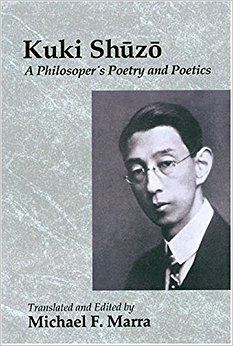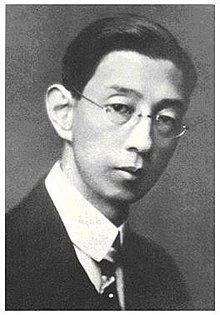Region Japanese philosophy Name Shuzo Kuki Influenced Takeo Doi | School Kyoto School Role Philosopher Education University of Tokyo | |
 | ||
Born February 15, 1888 Tokyo Prefecture Era 20th-century philosophy Main interests Aesthetics, Culture, Contingency Died May 6, 1941, Kyoto, Kyoto Prefecture, Japan Influenced by Martin Heidegger, Kitaro Nishida, Henri Bergson Books The Structure of Iki, Reflections on Japanese, Kuki Shuzo Similar People Martin Heidegger, Kitaro Nishida, Henri Bergson, Emmanuel Levinas, Gilles Deleuze | ||
Shūzō Kuki (九鬼 周造, Kuki Shūzō, February 15, 1888 – May 6, 1941) was a prominent Japanese academic, philosopher and university professor.
Contents
Early life

Kuki was the fourth child of Baron Kuki Ryūichi (九鬼 隆一) a high bureaucrat in the Meiji Ministry for Culture and Education (Monbushō). Since it appears that Kuki's mother, Hatsu, was already pregnant when she fell in love with Okakura Kakuzō (岡倉 覚三), otherwise known as Okakura Tenshin (岡倉 天心), a protégé of her husband's (a notable patron of the arts), the rumour that Okakura was Kuki's father would appear to be groundless. It is true, however, that Shūzō as a child, after his mother had separated and then divorced his father, thought of Okakura, who often visited, as his real father, and later certainly hailed him as his spiritual father. From Okakura, he gained much of his fascination for aesthetics and perhaps foreign languages, as indeed his fascination with the peculiar cultural codes of the pleasure quarters of Japan owes something to the fact that his mother had once been a geisha.
At age 23 in 1911 (Meiji 44), Kuki converted to Catholicism; and he was baptized in Tokyo as Franciscus Assisiensis Kuki Shūzō. The idealism and introspection implied by this decision were early evidence of issues which would have resonance in the characteristic mindset of the mature man.
A graduate in philosophy of Tokyo Imperial University, Kuki spent eight years in Europe to polish his knowledge of languages and deepen his already significant studies of contemporary Western thought. At the University of Heidelberg, he studied under the neo-Kantian Heinrich Rickert, and he engaged Eugen Herrigel as a tutor. At the University of Paris, he was impressed by the work of Henri Bergson, whom he came to know personally; and he engaged the young Jean-Paul Sartre as a French tutor. It is little known outside Japan that Kuki influenced Jean-Paul Sartre to develop an interest in Heidegger's philosophy.
At the University of Freiburg, Kuki studied phenomenology under Edmund Husserl; and he first met Martin Heidegger in Husserl's home. He moved to the University of Marburg for Heidegger's lectures on phenomenological interpretation of Kant, and for Heidegger's seminar "Schelling's Essay on the Essence of Human Freedom." Fellow students during these years in Europe were Tetsurō Watsuji and Kiyoshi Miki.
Career
Shortly after Kuki's return to Japan, he wrote and published his masterpiece, The Structure of "Iki" (1930). In this work he undertakes to make a phenomenological analysis of ‘iki’, a variety of chic culture current among the fashionable set in Edo in the Tokugawa period, and asserted that it constituted one of the essential values of Japanese culture.
Kuki took up a teaching post at Kyoto University, then a prominent center for conservative cultural values and thinking. His early lectures focused on Descartes and Bergson. In the context of a faculty with a primarily Germanic philiosophical background, his lectures offered a somewhat different perspective based on the work of French philosophers.
He became an Associate Professor in 1933 (Shōwa 8); and in that same year, he published the first book length study of Martin Heidegger to appear in Japanese. In this context, it is noteworthy that the German philosopher explicitly referenced a conversation "between a Japanese and an inquirer" in On the Way to Language (Aus einem Gespräch von der Sprache). Also, Heidegger expressed a desire to have written the preface to the German translation of The Structure of "Iki"
At the University of Kyoto, Kuki was elevated to Professor of Philosophy in March 1934 (Shōwa 10). The next year, he published The Problem of Contingency, also known as The Problem of the Accidental. This work was developed from his personal experiences in Europe and the influences of Heidegger. As a single Japanese man within an encompassing "white" or non-Japanese society, he considered the extent to which he became a being who lacked necessity. His Kyoto University lectures on Heidegger, Man and Existence, were published in 1939.
From the mid-thirties, while Japan drifted towards totalitarianism and the war in China dragged on, Kuki seemed not to be much disturbed by the growth of fascism.
In 1941, Kuki died prematurely from consequences following an attack of peritonitis.
